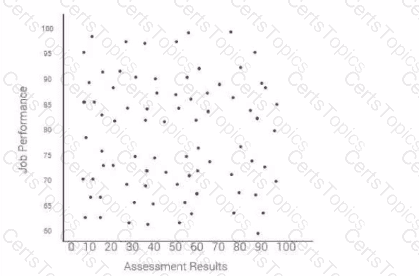The type of market characterized by identifying and designing products or services for a small profitable marketplace segment is:
A pregnant employee in a manufacturing plant discloses the pregnancy on the first day of employment. The employee works an overnight shift and does not have an accommodation request. The employee is observed getting sick in the bathroom during the lunch break. The supervisor contacts HR for guidance. HR should advise the supervisor to:
The employer cannot terminate or otherwise discipline the employee for organizing efforts because the:
The primary reason organizations develop reward strategies is to:
In compensation system development, internal equity conflicts directly with which other element?
In the absence of ethics programs, employees are most likely to make decisions based on:
An organization's employment brand is primarily driven by:
Which of the following best describes the process of identifying personal development needs that involves input from co-workers, subordinates, and superiors?
An organization receives the following job analysis results. Which of the following actions should the organization implement to improve job satisfaction? (Select TWO options.)
Dimension (Score 1–5, 5 being high)
Skill Variety: 3
Task Identity: 2
Task Significance: 4
Autonomy: 2
Feedback: 3
Which of the following is the purpose of the business impact analysis when creating a business continuity plan?
During an I-9 audit, the following errors are discovered: three I-9 forms for current employees cannot be located, two forms are missing the employer signature, and all forms are maintained in a shared, unlocked file cabinet.
Completion of new I-9 forms for the three employees whose forms cannot be located will:
An organization allows employees to access the Internet on their workstations for limited personal use. An employee is suspected of excessive Internet use during work hours, including reading personal email. The best course of action for the employer is to:
Business plans support organizational decisions when they are used as a:
The most effective talent management strategy in the growth phase of an organization's lifecycle is to:
The most significant benefit of measuring the results of a training program is knowing:
An HR director decided not to interview a qualified applicant because of personal knowledge that the applicant's family has a history of cancer. The director's decision created an alternative risk of:
Which of the following is best used to identify development needs that support employment forecasting strategies?
Based on the results of a general abilities test below, which of the following decisions should the organization make"?

In designing a total compensation strategy, organizations should first consider:
Which of the following is a diversity strategy that attempts to embrace and leverage all employee differences to benefit an organization?
An employee with previously good attendance and performance reviews is exhibiting increased incidences of tardiness, absenteeism, and mistakes. The manager suspects that the employee may have a drinking problem. In investigating this situation, the first consideration is to:
Assessing alignment between the organization's vision and HR processes can best be achieved by:
The success of employee wellness programs in decreasing healthcare costs is most dependent on:
In assessing training, the three broad areas of measurement that are most important to management are cost, change, and:
The most desired outcome in mergers and acquisitions (MandA) is:
An HR director has been hired by a high-technology business that has been growing at a rapid rate. There are 300 professional employees in manufacturing and 80 in clerical and laboratory support. There has been no formal human resource function in the past, with each department head controlling the hiring, salary adjustments, and other details. There are no established working hours except for non-exempt employees and the work environment is very informal in dress and supervisory relationships. The president wants the new director to identify the key areas of importance. Which of the following should be done first if the president indicated a desire to establish a formal pay program?
The most effective way an organization can optimize Sarbanes-Oxley Act (SOX) controls is to:
Key factors that contribute to a successful restructuring of the HR function include:
From a training perspective, the primary concern of an external growth strategy is to:
What can an employer legally do when a union approaches employees about forming a bargaining unit?
During mergers and acquisitions (MandA), an executive is likely to be protected financially with a:
The most effective corporate social responsibility (CSR) program is one that:
The most important consideration when designing a total rewards program is that:
Which of the following presents the greatest difficulty in using a profit-sharing plan as a means of rewarding employees?
During integration following an acquisition, which of the following are the most critical HR actions? (Select TWO options.)
Which of the following reward strategies improve employee retention? (Select TWO options)
The most critical security factor HR should consider before posting an organizational chart on its intranet is the:
The primary reason that organizations outsource training initiatives is that:
The main objective of team coaching is to:
When administering layoffs, which of the following is the most important factor in mitigating risk?
Which of the following strategies is used to connect executive performance to organization objectives?
Which of the following is the most important way to engage employees early in their careers?